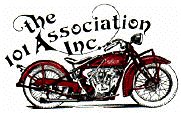It isn't always needed to replace a flywheel even it it has been in a breakdown. It can be marred at the edge without compromising strength. However the Indian windowed flywheels are notoriously weak at the tapers and crack easily when reused, trying to torque nuts to final specifications (According to Service Shot No. 141-April 11 1944, not more than 75 fp-lb=101 Nm=10kg-m!) Use less torque when truing up, before final torque and last check up.
I recommend always to replace windowed flywheels for new manufactured steel flywheels because a flywheel breakdown is mostly sudden, final and very unhealthy in the case you crash at speed. Steel flywheels withstands easily (100 fp-lb=135 Nm=13,7 Kg-m) torque on the nuts and are in most cases easier to true up. In a pinch, use the newer Scout flywheels that does not have windows but still use the lower nut torque on those.
Next better step is to use Z marked flywheels that are cast steel and can take the higher torque. Best is to use new repro steel flywheels. Combining unmatched flywheels can be a hit or miss, most often it is a miss and render it very hard or impossible to true up the crank to acceptable specifications. Width, and with that weight, can vary on cheeks even with same cast number.
Be aware if buying Z marked flywheels. Or solid cast flywheels. Some (or I don't know if all) has a larger taper than the 101 on the drive shaft side and in that case 2 pinion side flywheels has to be matched. I don't know what year that larger drive shaft was implemented but those might be for 841, 648 or perhaps Sport Scout. I bought a pair Z wheels for a lot of money and of course was shipped 2 drive side flywheels...
A matched pair of Scout flywheel cheeks weigh approximately
my 101 orig. 37 and 45 =7,7kg
my "Z" big taper =9,1kg
T&O ca 19 lbs =8,4-8,6kg
S&S 16 lbs. =7,25kg
Sport Scout stock 17.8 lbs.=8.07kg
Flywheel heavy weight is good for our most often used low speed torque, when getting away from stops and such.
Shafts. Shafts are not always ground in a machine that has centers, often they are ground centerless and that makes turned centers not always in center! A good practise is before the start, put the shaft between centers and check if the tapers and bearing surfaces are concentric!
Remember to check up each flywheel with its shaft individually before mounting the crank pin. With the shaft between centers, acceptable side throw on the flywheel is...tiny to nothing (how much hair do you have on your head?).
Remove and reassemble a shaft instead of hammer on it, that goes for a assembled crank too. Check or replace the nut, if it is overstressed or ground out of plane it will pull the shaft skew. The shafts may have to be taken out and retorqued multiple times. Maybe you even have to grind the taper(s).
When that is done, a straight ruler across the crank cheeks and clamp between with a pair of flat ground channel iron is a good start to align the 2 halves. When pounding on the cheek, do not hammer on the shafts and always use a wooden block between or a hammer with lead, brass or rawhide face. A dead-blow plastic one is good too. If 5 or more thou out (10 hundreds of a millimeter) it is gentler to take it apart and reassemble instead of trying to pound it straight. Pry with a short bolt and nut, or pound on wedges preferably of hardwood or plastic if the crank is pinched.
Acceptable throw between centers on the shafts on a assembled crank is...nothing to...1 thou, maybe a tiny bit more, depends if it is on the long or short shaft for each side on the stand. (2 to 4 hundreds of a millimeter) It is not always possible to get it that straight and in the end it is you that decide what you accept. But....perhaps with a little more work, it is possible to get better ;-)
https://www.youtube.com/watch?v=9VSOg1yTK08&list=PL_rtYbjyQDbcQ1DWntfQDCIZPIbjcw0N-&index=4&t=0s
A truing jig can be made simple by cut V's in flat bars and arrange that close to the cheeks, on the bearing surface. That can in fact be truer than running the crank between centers. Shafts are not always ground in a machine that has centers, often they are ground centerless and that makes turned centers not always in center! A good practise is to check if that is the case before the start!
A problem with that V block truing method can be key slots or irregularities at the end of the shafts where you want to measure, but a fitting a bearing temporary pressed on at the end can be a solution to that, bearings are always ground very precise.
Now, if you want a degree of precision, check out Tony Foales jig. https://www.homemadetools.net/forum/mc-crankshaft-alignment-balance-tool-64019#post100529
And that is just the start. If you finally want to know the really important stuff, like how the crankpin behaves when the crank is fixed by the bearings and turning, then a precision sliding jig for the entire crank assembly is needed.


